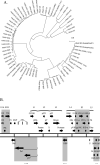Molecular evolution of human species D adenoviruses
- PMID: 21570490
- PMCID: PMC3139803
- DOI: 10.1016/j.meegid.2011.04.031
Molecular evolution of human species D adenoviruses
Abstract
Adenoviruses are medium-sized double stranded DNA viruses that infect vertebrates. Human adenoviruses cause an array of diseases. Currently there are 56 human adenovirus types recognized and characterized within seven species (A-G). Of those types, a majority belongs to species D. In this review, the genomic conservation and diversity are examined among human adenoviruses within species D, particularly in contrast to other human adenovirus species. Specifically, homologous recombination is presented as a driving force for the molecular evolution of human adenoviruses and the emergence of new adenovirus pathogens.
Copyright © 2011 Elsevier B.V. All rights reserved.
Figures





References
-
- Gene Therapy Clinical Trials Worldwide [January 27, 2011];J Gene Med. 2010 http://www.abedia.com/wiley/vectors.php.
-
- Abbink P, Lemckert AA, Ewald BA, Lynch DM, Denholtz M, Smits S, Holterman L, Damen I, Vogels R, Thorner AR, O'Brien KL, Carville A, Mansfield KG, Goudsmit J, Havenga MJ, Barouch DH. Comparative seroprevalence and immunogenicity of six rare serotype recombinant adenovirus vaccine vectors from subgroups B and D. J Virol. 2007;81:4654–4663. - PMC - PubMed
-
- Adrian T, Bastian B, Benoist W, Hierholzer JC, Wigand R. Characterization of adenovirus 15/H9 intermediate strains. Intervirology. 1985;23:15–22. - PubMed
-
- Adrian T, Wigand R. Adenovirus 3-7, an intermediate strain of subgenus B. Intervirology. 1986;26:202–206. - PubMed
-
- Adrian T, Wigand R, Wadell G. Serological and biochemical characteristics of intermediate adenovirus strains of subgenus D. Arch Virol. 1987;97:347–357. - PubMed
Publication types
MeSH terms
Grants and funding
LinkOut - more resources
Full Text Sources

